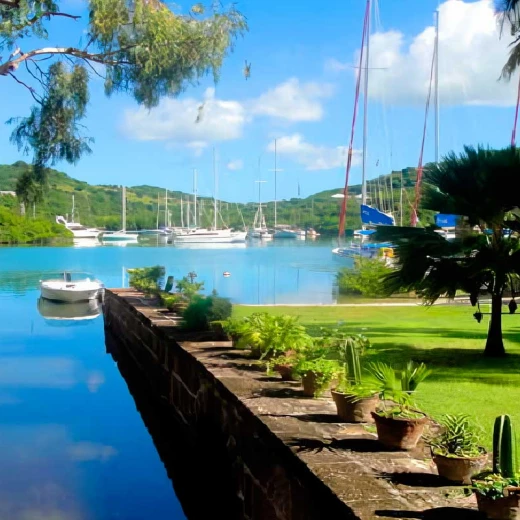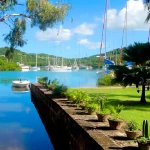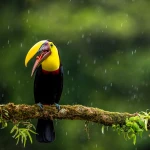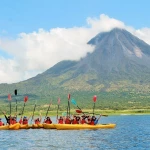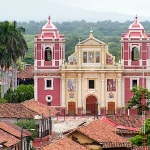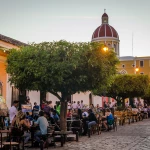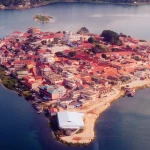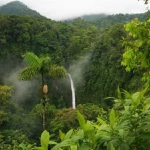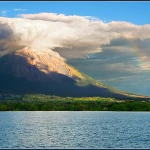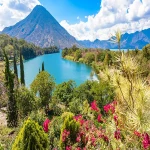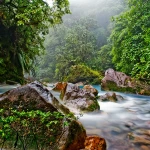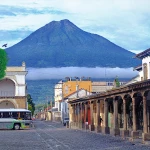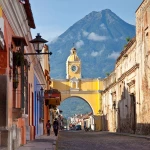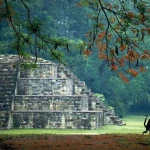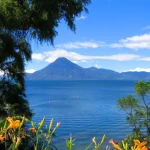Click Image for Gallery
Guatemala - Honduras - El Salvador-Nicaragua –Costa Rica
Day 1. Guatemala City / Antigua
Arrival at La Aurora International Airport. You will be met at the airport and transferred to the hotel in Antigua. Overnight at Hotel Villa Colonial.
Antigua Guatemala.png
Day 2. Antigua
Antigua City Tour: Antigua lies in the wide mountain valley of Panchoy, sandwiched between the cones of the volcanoes of Agua, Acatenango and Fuego. The city was founded in 1543 as the third capital of Guatemala, and was called Santiago de Guatemala. And only after the strong earthquake occurred in 1773, the capital had to be moved to a new place in Guatemala City. The city reached its peak by the middle of the 18th century, when an unprecedented construction boom tripled and its population grew to fifty thousand people. By 1773, this city had about 25 churches, 5 women's, 8 men's monasteries and a cathedral built in 1680 and was compared only with the cathedral in Mexico City and Lima, Peru for its beauty and majesty of construction. In 1773 there were 3 very strong earthquakes: the very first that destroyed almost the entire city, all the churches and monasteries happened on July 29, 1773 on St. Martha's Day, so it was called the Santa Marta earthquake. But the most important museum in Antigua is the city itself, its streets, where you can study its history just by walking it. Overnight at Hotel Villa Colonial.
(Meals: B)
guatemala lake atitlan.png
Day 3. Antigua / Pacaya Volcano / Atitlan Lake
Only 67 km from Antigua Guatemala is the most active and beautiful volcanic complex in Central America, Pacaya Volcano. Its main crater reaches a height of 2,552 meters above sea level. From 1961 to March 2002, a total of 14 major eruptions were recorded, and many others were less intense. In fact, Pacaya volcano is a “volcanic complex”, which, according to Carlos Saper, is “the most interesting volcanic complex in Central America in terms of the number of eruptive cones, craters and changes that can be observed constantly.”
According to volcanologists, the crater in the west began to form more than 2,000 years ago, and Cerrohino on the one hand and Pacaya volcano on the other began to form from its two ends. We will begin our ascent from a height of 1,900 meters above sea level and rise to 2,300 m. After the descent we continue to Lake Atitlán. Overnight at Hotel Villa Santa Catarina. (Meals: B)
countries/costa-rica/zdenek-machacek-1440919-unsplash.jpg
Day 4. Atitlán Lake
Today we will see the most interesting cities where Maya Tzutujil still live on Lake Atitlan. And we will start with San Juan. Boat trip to San Juan takes about 30 minutes. San Juan is the cleanest and tidiest town on the lake. There are many art galleries, whose artists paint in the style of Naive or primitivism. After, we will transfer by boat to the other side of the lake in the city of Santiago Atitlan. Santiago Atitlan, founded in 1547 at the foot of the Atitlan volcano, is the largest city with a population of 32 thousand people, 95% of which are Maya Tzutujil. The local population lives of fishing, farming, and making kayukos (local canoes). Artisans specialize in painting, woodwork and weaving. Santiago is the city of worship of Maximon – a pagan deity or god of the Mayan people, who are offering donations in the form of alcohol and cigars. We will also v sit the local Catholic church, where two religions merged - Catholicism and Mayan beliefs and take a walk past the local city hall, where the elders of the city are sitting, dressed in white striped shorts and birds embroidered at the bottom. Our final stop, before heading back to Panajachel, will be San Antonio Palopo. Overnight at Hotel Villa Santa Catarina. (Meals: B)
guatemala lake atitlan.png
Day 5. Chichicastenango / Guatemala City (Thursday or Sunday)
Today we will go to the largest highland Mayan Market, Chichicastenango (only Thursday or Sunday). Surrounded by valleys and mountains that cover the horizons, Chichicastenango may seem isolated in time and space from the rest of Guatemala. When its narrow, cobbled streets and red tiled roofs are covered with fog, and this happens often, it may seem like you're in some kind of fairy tale. Crowds of sellers and tourist groups flock on Thursday and Sunday to the country's largest alpine market. The Catholic patron of the city is St. Thomas, in his honor the city of Santo Thomas was built in 1540 in the city. When the Catholic missionaries arrived, they destroyed the Mayan temple and built a white church in its place. The only thing left of the temple is 18 steep steps leading to the church by the number of months in the Mayan solar calendar Haab. Therefore, this church is probably the
most unique Catholic church in Guatemala due to religious symbiosis within the church. On the steps of the church they sell flowers, candles and fragrances. Like in the front of the pyramids, an altar is installed in front of the stairs - a round flat stone, from which smoke rises from the smoldering pomp in clubs. And what a market without shopping, so bring enough money with you to buy souvenirs. The Chichicastenango market is famous mainly for its textiles and masks. Back to Guatemala City. Overnight at Hotel Barceló Guatemala City. (Meals: B)
Lake Atitln.png
Day 6. Guatemala City / Flores, Peten / Tikal
Early flight to Flores. Visit of the most important archeological Mayan site in Guatemala. Tikal is 64 km from Flores, the beautiful capital of Peten, located on an island on Lake Peten Itza. Tikal means “a place where the voices of spirits are heard”, in comparison with other cities of the classical period it seems huge - this is the largest settlement of pre-Columbian America. Scientists came to this conclusion after a series of excavations conducted in the late 50s. It has been inhabited since 700 BC. until 900 AD, only then to be conquered again by the tropical jungle, from the beginning of the eleventh century until the beginning of the twentieth century, when Tikal was discovered and restoration work began.
The urban complex of Tikal (not counting the outskirts) occupied an area of about 16 square kilometers. It housed 3 thousand buildings, and the pyramids were distinguished by a specific style, not found anywhere else in Mesoamerica. The six pyramidal temples make a particularly strong impression, which look like real skyscrapers against the background of other structures of this type. No wonder archaeologists called Tikal-New York the Mayan civilization. Today Tikal National Park covers 575 square kilometers and in 1979 was listed as a UNESCO World Heritage Site as a cultural and natural heritage of mankind. Overnight at Hotel Villa Maya.
(Meals: B)
guatemala flores.png
Day 7. Flores / Rio Dulce / Livingston
Transfer to the Izabal department to the most picturesque river of Guatemala – Rio Dulce. In accordance with its peculiar geological history, which began at least 400 million years, Izabal is a complex mixture of karst caves and hills, rivers, lakes, marshes and large plains. You can find Mayan pyramids hidden in the rainforest and with so much vegetation and water, this region of Guatemala is a paradise for lovers of nature and birds. The natural area of Izabal resembles the richness of the Amazon forests. Izabal's rainforest is uniquely impressive. With the highest biological diversity
in the country, with an abundance of vegetation on the banks of the rivers, it is rightly called the jade coast. Transfer to a boat and a journey along the Rio Dulce: the sheer walls of the river canyon, thermal springs, the beauty of the tropical jungle will leave unforgettable impressions and of course the city of Livingston, where the Garifuna people live, the descendants of slaves exported from Africa.
Excursion to Livingston (it is impossible to get to the city by land, only by water) - a settlement of the Garifuna people with a unique culture that combines African, Caribbean and European elements. Spreading palm trees, reggae music and stunning seafood are the symbols of Livingston, allowing you to experience the true spirit of Jamaica in the center of Guatemala. During our trip you can try a typical Garifuna dish - tapado soup (seafood soup cooked in coconut milk). Overnight at Hotel Villa Caribe. (Meals: B)
Antigua_HillView.png
Day 8. Rio Dulce / Quirigua / Copan, Honduras
Transfer and tour to Quiriguá Archaeological Site. The park is located on the west bank of the Motagua River. This Mayan city is characterized mainly by its majestic stelae that are the largest and best preserved of the Mayan World. Most of the monumental constructions, the acropolis, and the stelae were erected during the following 60 years of reign of the new Quiriguá dynasty, a dynasty that dominated the region of the Copán river and the Motagua river. In this historical context, stela E is carved, 10 meters high and weighing 55 tons, which constitutes the largest sculpture of all those located in the Great Plaza, a ceremonial space where one can appreciate the exceptional collection of sculptural monuments of the park that It includes zoomorphic altars of exceptional artistic quality, which is why it has been
declared a World Heritage Site since 1981 by UNESCO. Transfer to Honduras.
Overnight at Hotel Clarion Copan Ruinas (Meals: B)
Antigua Guatemala.png
Day 9. Copan, Honduras / San Salvador
Visit the famous Mayan ruins of Copan. The main value of Copan is the unreal beauty and accuracy of art on stelae. This site of the Mayan civilization was called Athens of Mesoamerica. There you will even find a stelae made in three dimensions. A true work of art is considered to be the Mayan Staircase with hieroglyphs during the classical period. Each of its 63 steps is decorated with complex letters, and balustrades with the image of snakes and birds are erected on the sides. Transfer to San Salvador. Overnight at Hotel Barceló San Salvador. (Meals: B)
copan gonduras.png
Day 10. San Salvador City Tour / San Andres & Joya de Ceren
We will visit the very interesting historical center of San Salvador, visit the El Rosario church with a modern and very colorful design, the national palace, the national theater and the Metropolitan Cathedral. Then, Joya de Ceren and San Andres are the main archaeological sites that we will discover on this tour. In this tour we will observe this fact closely. Among the many civilizations that have lived in El Salvador, one of the most important has been the Mayans. The Mayans are known to have developed complex societies with impressive temples in the Mesoamerican area. Overnight at Hotel Barceló San Salvador. (Meals: B)
countries/gonduras/2.jpg
Day 11. San Salvador / La Unión / Potosi, Nicaragua / Leon / Managua
Transfer to the La Union to take a Ferry to Nicaragua. Then we will drive to the city of Leon. Just before arriving, we will visit the Pompey of Nicaragua, the old city of Leon to see the first city built by the Spanish people in 1524 and abandoned in 1610 because of the volcanic eruptions of Momotombo volcano. After this stop we will continue to the new city of Leon where will visit the biggest church in Central America, the Ruben Dario Museum, The Ortiz Gurdian Museum and the Murals of
the Revolution. Transfer to Managua.
Overnight at Hotel Los Robles. (Meals: B)
countries/nikaragua/2.jpg
Day 12. Managua / Masaya Volcano / Granada
Begin your journey in the city of Managua, where we will present you the culture and
history of Nicaragua through museums, parks and historic sites of the capital of the
Republic. Then we will travel to the Masaya Volcano National Park, the first and largest national park in the country to observe the impressive Volcano Masaya and visit its active crater. We will visit the famous Masaya craft market. Transfer to Granada known as the oldest colonial city of Mainland America, has survived pirate’s attacks, civil wars, fires and more in its rich history, since its foundation in 1524. We will start this tour full of history visiting the main Plaza, La Casa de los Leones cultural center, the San Francisco museum and convent, the Ceramic museum, La Merced church and La Calzada. Overnight at Hotel Colonial. (Meals: B)
nicaragua isla ometepe.png
Day 13. Granada / Pacific Coast
Transfer to Pacific Coast in Costa Rica. Overnight at Hotel Pasatiempo. (Meals: B)
granada nic.png
Day 14. Pacific Coast
Free Day. Overnight at Hotel Pasatiempo. (Meals: B)
countries/costa-rica/costa-rica-arenal-middle.jpg
Day 15. Pacific Coast / Monteverde
Transfer to Monteverde. Located in the heart of the Monteverde Cloud Forest, Selvatura Zip Lines and Hanging Bridges consist one of the few tours in Costa Rica that literarily take you deep within the primary Monteverde Cloud Forest, providing a precious and unique experience we guarantee you'll always remember.
Overnight at Hotel Montaña Monteverde
(Meals: B)
costa rica la fortuna falls11.png
Day 16. Monteverde / Arenal Volcano
Explore the enchanted Monteverde Cloud Forest Reserve with a set of expert eyes on a guided hike. You will explore several trails in search of birds and mammals and discuss the amazing diversity of plants. The tour is essentially a natural history walk in which you will learn about the incredible diversity of flora and fauna and many of the unique relationships many cloud forest species have with each other. Travel between Monteverde and Arenal with Taxi-Boat-Taxi. This van-boat-van service is the fastest and a very scenic way to travel between the Arenal Vocano and the cloud forests of Monteverde. Plus, you get to have a fun and scenic boat ride on Lake Arenal and see gorgeous views of Arenal Volcano! Overnight at Hotel Arenal Paraíso Resort & Spa. (Meals: B)
countries/costa-rica/costa-rica-arenal-middle.jpg
Day 17. Caño Negro Wildlife Refuge
Breakfast at the Hotel. You will enjoy the Caño Negro & Río Frío Boat Tour Specially for Nature Lovers! This tour highlight is a boat ride on the Frío River, starting at Los Chiles, little town located 4 km from the Nicaraguan border. This river is part of the Caño Negro Wildlife Refuge – a Ramsar site- here you will find one of the most diverse flora and fauna habitats in Costa Rica. Along the river it is possible to observe great quantity of birds like the snake-bird, herons, cormorants and animals such as: howler, spider or even white face monkeys, three - toed sloths and some reptiles like caimans, Jesus Christ lizards and turtles. After lunch, back to Arenal. Overnight at Hotel Arenal Paraíso Resort & Spa. (Meals: B, L)
countries/nikaragua/2.jpg
Day 18. Arenal Volcano / Poas Volcano / La Paz Waterfall Gardens
This morning you will be picked a your hotel in Arenal for your journey towards the Central Mountain Range where you will visit La Paz Waterfall Gardens and Poas Volcano. As we ascend towards the Poas Volcano we will notice the change in temperature and vegetation; we will see coffee plantations as well as fern, flower and strawberry farms along the way, creating a beautiful landscape. In the Poas Volcano where we will not only admire the impressive main crater with its sulfur fumaroles, but also learn about the different ecosystems in this beautiful national park. Following the visit to the volcano we will continue to La Paz Waterfall Garden for lunch and tour. On arrival to the La Paz, we will walk through a trail, leading to a spectacular waterfall in the middle of the rainforest. Inside the park e will also visit the hummingbird gallery, the serpentarium, the bird house, the butterfly garden and the frog’s exhibit. Back to San José. Overnight at Hotel Exe San Jose Center. (Meals: B, L)
costa rica la fortuna falls11.png
Day 19. San José
Transfer to Juan Santamaria International Airport. (Meals: B)
CostaRicaJungle11.png

